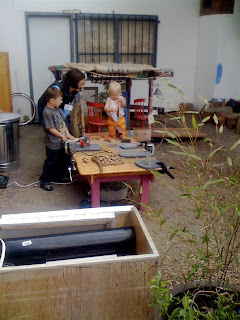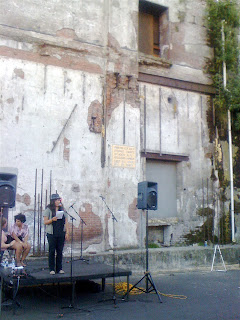I suppose I should start by explaining why it appears we are working with tombstones. My daughter's birthday falls the day before Halloween and we've often celebrated with a big party including all her classmates. A couple years ago I filled the lawn with tombstones for each of our guests, which they were to take home as party favors. Several were left behind.
The point is that they are painted wood which makes them perfect targets for our vibrating hand sander. We've found that sanding is far more interesting when progress can be judged both visually and tactiley.
This is a seriously cool power tool for even the youngest children.
An adult can help keep this tool under control by holding
the cord when less experienced users are starting out.
Two-year-old Henry didn't mind putting on the safety glasses, but he didn't want to keep them on. Every time I handed the sander to him, he would remove the glasses. I would then withdraw the sander and help him put on his glasses, saying, "You have to wear these to use the sander." I would then hand him the sander again, only to have him again remove his glasses. We went around like this for quite some time before his desire to use the sander finally overcame his desire to remove the glasses.
The older kids didn't need such a hands-on approach and even took on some of the other important aspects of sanding, like proper clamping.
Unlike some of the 2-year-olds, the older kids have now accepted safety goggles in the same spirit in which they wear their bicycle helmets and seat belts -- as a matter of course.
Meanwhile, we used my jigsaw to cut wood rounds, that we are then drilling to make into beads. Several of the older children took a crack at it, but Georgia was the only 2-year-old to summon up the courage to try this noisy tool. She successfully cut a half dozen beads, growing more confident with each pass of the saw. I didn't get pictures because, naturally, I had my hand firmly on this tool the whole time, no matter what the child's age.
In spite of the drama of the power tools, however, as we settled in yesterday we did a lot more drilling than sanding or sawing, using our egg beater style drills.
And again, even our youngest students were successful.
Some of us need to stand on milk crates in order
to properly leverage the tool.
She insisted on wearing her safety glasses upside down.
Here a 6-year-old is teaching a 2-year-old.
There is no doubt that the level of competence with tools, both among the children as well as the adults who are teaching them, has soared since we first introduced them on a daily basis back in March. I think we all felt a mild sense of panic back then when we saw young children, for the first time, holding hammers and saws. Now that it's an every day occurrence, now that both the children and adults have gained experience, now that we've gotten over our prejudices about what children are capable of doing, now that some of the basics of safety and technique have become internalized, a measure of calm and concentration has come to characterize our construction/tinkering area.
When we set out on this course, I tended to think of this area as an outdoor iteration of our indoor block area, but the play here (if you can even call it play) has a much different character than traditional block play, at least as I've usually encountered it at Woodland Park. There are always some block players, of course, who demonstrate an intense sense of purpose, but around the work bench this is the rule more than the exception. And, of course, there is none of the build-it-up-and-knock-it-down circular play here. Very few of the children come charging up to the work bench willy nilly the way they often do indoors, but instead tend to approach with a cautious reading of the situation, nearly all of them taking at least a few moments to observe before diving in.
We aren't creating a lot of "finished projects" at the work bench, the way we do at the block area or art table. There are few moments to make possessive declarations about nouns like, "This is my castle" or "This is my bird painting." It's much more about verbs: "I hammered that nail" or "I cut the wood." It is, so far, more a place to practice skills. I'll be interested to see how this changes as children gain experience with the capability of our tools, especially those starting out so young and who will graduate with 3 full years of practice under their belts. I know that once I've become confident using a new tool, I find myself looking for projects that require my new skills -- projects like cutting out 50+ tombstones.
When Charlotte and Georgia and Henry and Suriya are 5, what will they build? I really want to know. The mind reels.


























































